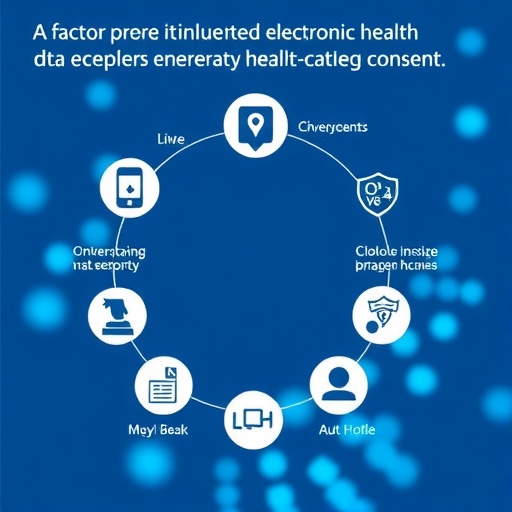
In the evolving landscape of healthcare, the question of consent for electronic health information exchange has become a critical topic. The study conducted by Keuper et al. offers compelling insights into the factors influencing patients’ willingness to share their health data electronically. As the integration of technology in healthcare becomes more prevalent, understanding these determinants is essential for policymakers, healthcare providers, and patients alike. The research delves deep into the perceptions and attitudes surrounding electronic health records (EHRs) and their utility, aiming to enlighten stakeholders on fostering a culture of transparency and trust.
One prominent aspect highlighted in the study is the role of awareness and understanding of the technology. Many patients remain uninformed about how their data will be utilized and safeguarded. This lack of awareness can lead to anxiety and skepticism, ultimately contributing to a reluctance in providing consent. It is crucial for healthcare systems to engage in educational initiatives that demystify electronic health exchanges for patients, thereby promoting informed consent. Through targeted communication strategies, healthcare providers can address common concerns that patients may harbor regarding data privacy and the intended use of their health information.
In addition to awareness, the researchers delve into the influence of individual motivations influencing consent. Factors such as personal health experiences, the perceived benefits of data sharing, and trust in healthcare providers play a significant role in shaping patients’ decisions. The study outlines that patients perceive the value of data sharing more positively when they understand its potential to enhance care quality and improve health outcomes. Healthcare organizations must therefore emphasize the positive implications of electronic health information exchange, illustrating how it can lead to more personalized and effective care.
Another crucial determinant outlined in the research is the social influence on consent behavior. Patients are often swayed by their family and friends’ opinions regarding sharing health information electronically. Social networks can either amplify individual fears or encourage consent, depending on the shared experiences within these networks. As such, fostering environments that prioritize collective sharing through community forums or support groups may enhance individuals’ trust in electronic health information exchange and motivate consent. This community-based approach could prove instrumental in disseminating information that eases anxiety and enhances understanding of the technology.
In terms of demographic factors, the study notes that age, education level, and socioeconomic status play significant roles in consent patterns. Younger individuals, who tend to be more technologically savvy, may exhibit greater willingness to consent, while older populations may display hesitance due to unfamiliarity with digital formats. Furthermore, individuals with a higher education level may vary in their responses based on their grasp of technological implications. Tailoring outreach efforts to address specific demographic concerns could prove beneficial in bridging the consent gap, thereby ensuring broader participation in electronic health information exchange initiatives.
The implications of this research extend beyond the immediate patient-provider relationship; they influence broader healthcare systems and policies. By pinpointing the determinants of consent, policymakers can develop frameworks that promote transparency and patient-centric approaches in electronic health information exchange. Legislative measures can also be introduced to ensure that patients’ rights to privacy and control over their data are protected while offering guidelines for healthcare organizations on how to effectively communicate the benefits of data sharing.
Moreover, the implementation of robust data protection measures can alleviate many privacy concerns that patients harbor. The integration of advanced encryption technologies and strict access controls could bolster trust among patients regarding how their health information is stored and shared. As these safeguards are enacted, continuous assessments should be conducted to ensure their efficacy, cumulating in a feedback loop that allows for ongoing improvements based on patient experiences and concerns.
The research underscores the importance of trust in building an effective electronic health information exchange system. Patients’ trust not only focuses on the healthcare provider but extends to institutions and technologies involved in managing their health data. Trust is intricately linked to transparency, which can be cultivated through open dialogues about data handling practices, potential risks, and benefits. By sharing this information candidly, healthcare providers can foster confident relationships with patients, which can lead to higher rates of consent for health information exchange.
Further investigations into consent determinants could also explore the intersection between technology acceptance models and healthcare settings. Understanding how different settings influence technology acceptance could lead to tailored consent strategies. For instance, hospital environments that prioritize advanced technologies may attract more tech-savvy patients, whereas community clinics might need a different approach that emphasizes personal relationships.
Another avenue mentioned in the study is the potential role of public opinion in shaping the policy landscape surrounding electronic health information exchange. As societal attitudes shift toward recognizing the value of health data in improving care, it could lead to increased acceptance and support for legislation promoting data sharing initiatives. Public campaigns that emphasize the collective benefit of shared health data could catalyze changes in the general discourse surrounding consent and health information exchange practices.
The intersection of ethics and technology also arises as a central theme in exploring consent for electronic health information exchange. The ethical considerations surrounding data sharing must align with patients’ autonomy and right to make informed choices about their health information. This ethical framework should serve as the foundation for developing policies and clearing the path for responsible electronic health information exchange practices that prioritize the patient’s voice.
Ultimately, the study by Keuper et al. is a call to action for stakeholders across the healthcare spectrum. By understanding the multi-faceted determinants of consent, the healthcare community can work collaboratively to establish systems that not only respect patient privacy but also cultivate an environment in which sharing health information is viewed as beneficial. This paradigm shift will require ongoing dialogue, innovation, and advocacy—a concerted effort to bridge the gap between technology and patient trust.
In conclusion, the findings of this observational retrospective study herald a pivotal opportunity for the healthcare sector. By recognizing and addressing the various determinants influencing consent for electronic health information exchange, stakeholders can create inclusive, secure, and beneficial systems that empower patients. This evolution towards a connected healthcare ecosystem will lay the groundwork for advancements in personalized medicine, ultimately improving patient outcomes and fostering a healthier society.
Subject of Research: Determinants of consent for electronic health information exchange
Article Title: Determinants of consent for electronic health information exchange: an observational retrospective study
Article References:
Keuper, J., Hek, K., van Tuyl, L.H.D. et al. Determinants of consent for electronic health information exchange: an observational retrospective study.
Health Res Policy Sys 23, 103 (2025). https://doi.org/10.1186/s12961-025-01377-x
Image Credits: AI Generated
DOI: 10.1186/s12961-025-01377-x
Keywords: consent, electronic health information exchange, patient trust, health data privacy, technology acceptance, healthcare policy
Tags: communication strategies for health data exchangedeterminants of health data sharing attitudeseducational initiatives for informed consentelectronic health data consentfactors affecting willingness to share health informationfostering trust in health technologymotivations for sharing personal health datapatient perceptions of health data privacypatient trust in electronic health recordsskepticism towards electronic health informationtechnology awareness in healthcaretransparency in healthcare data usage




